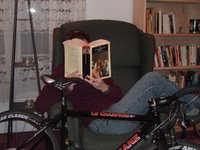I finished The Mezzanine last night and loved it. If you've ever been tempted to read Nicholson Baker but haven't yet, or even if you've never been tempted, I'd say give him a try. This is one sort of book I love very much -- a non-traditional narrative that's more about thoughts and ideas than about plot. It's the kind of book where the narrator's personality makes or breaks it; it's all about voice. If the voice is good, it doesn't matter what the subject is. It's a novel that's closer to the essay than it is to more traditional novels.
The subject of this book, that I say doesn't matter so much? Let's see. The main events include riding an escalator, contemplating why the two shoelaces on a pair of shoes snapped within a short time of each other, shopping at CVS, eating a cookie and milk, talking to work colleagues, and visiting the bathroom. The book describes the escalator ride from the vantage point of a few years afterward, and it moves backward from the escalator ride to describe the morning at work which precedes it and the lunch break which the ride brings to an end.
But these things aren't really the subjects of the book. The real subjects are the way the narrator's mind works and his enthusiasm for the little details of modern life. This enthusiasm is boundless. When the second shoelace snaps shortly after the first one did, the narrator sets off on a quest to discover how shoelaces wear out. Is it because of the stress caused by pulling the laces tight when he ties them? Or is it the wear on the laces caused by the slight friction of lace against shoe every time he takes a step?
Now that I think about it, I realize that there are a number of more traditional narratives and genres that the book plays with, one being the quest narrative. While a quest to discover why shoelaces wear and break might seem small, what this narrator is really after is knowledge of those details that shape our day-to-day lives that most of us don't even notice, much less understand. He's showing that those details matter -- they are our lives, after all. We are surrounded by things we don't understand, things we use without knowing where they came from or how they got to us, or how they function and why they break. He wants to dig those details out and examine them and understand them.
He also wants to understand the way the mind works. In one passage, he considers the "periodicity of regularly returning thoughts," the number of times he thinks of a particular thing a year. If he can study and chart this, he can understand his mental life much better; without this study, he has only a vague impression of what thoughts he actually devotes his energy to. He realizes how complicated such an endeavor would be, but he makes a chart with his best estimates, a chart that occupies a couple pages of text, and tells us that he thought about how "people are very dissimilar" about 16 times a year, and about how "people are very similar" about 12 times a year. And he thinks about staplers 7 times a year and escalator invention 12 times.
This sounds rather Proustian, doesn't it?
Some of these thoughts are inspired by Marcus Aurelius's Meditations, a book the narrator carries with him on his lunch break. Here is another traditional form Baker draws on, for his own book could be called meditations -- meditations on the world the narrator has found himself in. He never reads very much of Aurelius's Meditations, but he has it with him because he fell in love with one line he came across by chance while looking at the book in the bookstore. Here's the line:Manifestly, no condition of life could be so well adapted for the practice of philosophy as this in which chance finds you today!
The narrator's response to the line is this:Wo! I loved the slight awkwardness and archaism of the sentence, full of phrases that never come naturally to people's lips now but once had: "condition of life," "so well adapted for," "chance finds you," as well as the unexpected but apt rush to an exclamation point at the end. But mainly I thought that the statement was extraordinarily true and that if I bought that book and learned how to act upon that single sentence I would be led into elaborate realms of understanding, even as I continued to do, outwardly, exactly as I had done, going to work, going to lunch, going home, talking to L. on the phone or having her over for the night.
And that, you could say, is the book in a nutshell, from the enthusiasm in that opening "Wo!" to the list of things that make up an ordinary day at the passage's end, to the idea in the passage's middle that one can live an ordinary life profoundly.
And lest you think this book is all seriousness, let me say it's hilariously funny, and I often laughed out loud as I read. The bathroom scene -- generally I'm not big on bathroom humor, but that bathroom scene -- ah, just read it.
I haven't even gotten to the footnotes yet, but perhaps I'll come back to them tomorrow. I must talk about the footnote on footnotes and the footnotes on the resolution of the shoelace conundrum. It's a very moving passage, something I never thought I'd say about a passage on shoelaces.
Sunday, October 08, 2006
Nicholson Baker's The Mezzanine
Posted by
Rebecca H.
at
9:15 AM
![]()
Subscribe to:
Comment Feed (RSS)



|